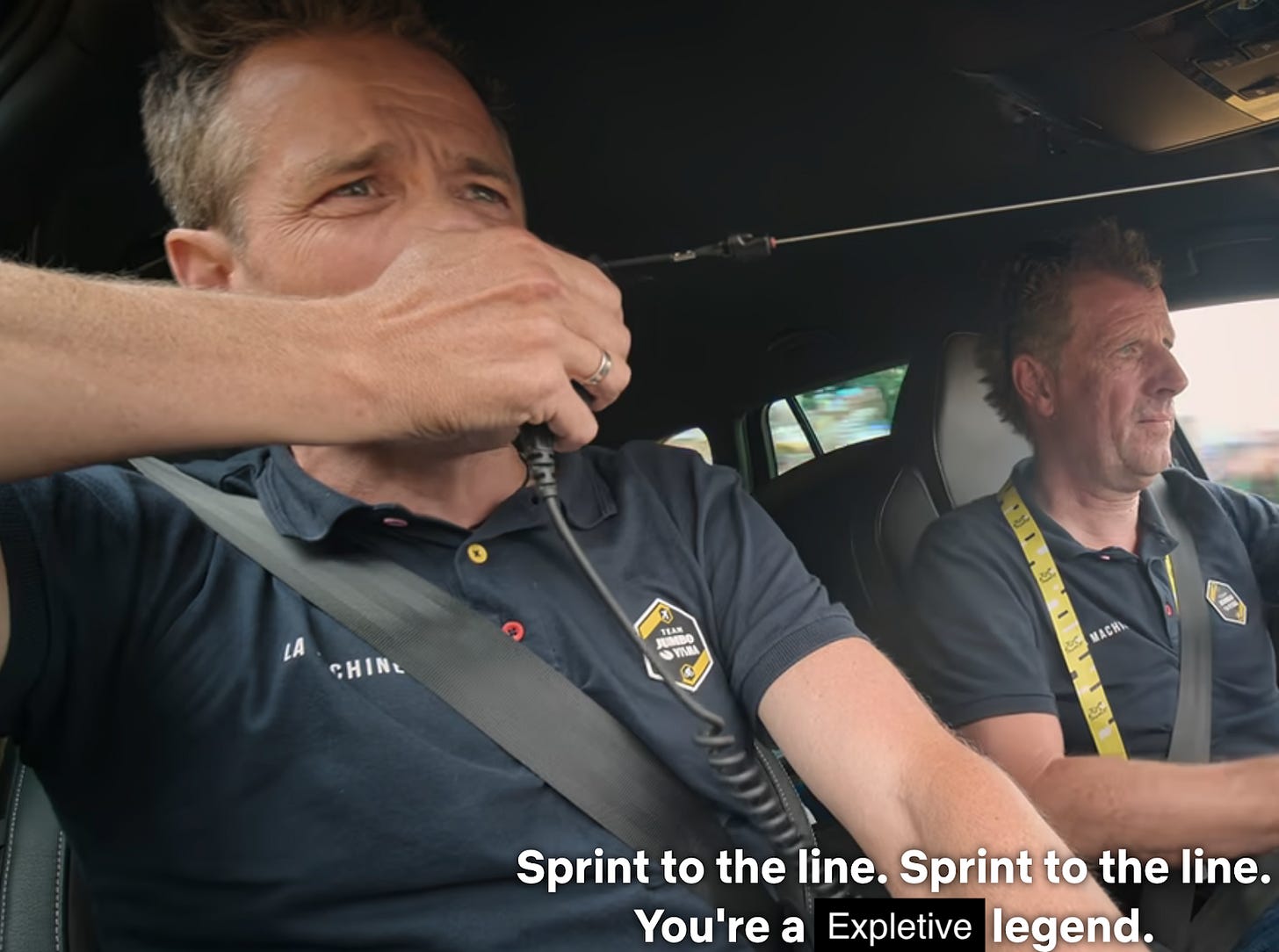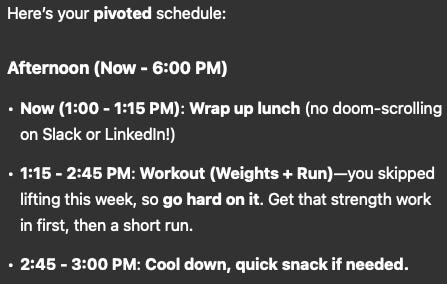Why You Need AI as Your "Directeur Sportif" Today
In the 2023 Tour de France, at a critical moment in the stage 16 time trial, world champion Jonas Vingegaard is pushing with everything he has to hold onto first place. Right in his ear, his Directeur Sportif, his coach Grischa Niermann, has been urging him on for weeks. Grischa knows Jonas inside and out, both psychologically and physiologically. Over and over, he shouts, “You’re a [expletive] legend, Jonas!”
And with that, Jonas explodes ahead to achieve one of the most remarkable time trial performances in history. A relentless and skilled coach in your ear can drive world-class performance.
Image credit: Netflix, Tour de France Unchained
’s book Co-Intelligence is insightful, built on lasting principles, and refreshingly short. In it, he lays out the concept of AI as Coach.The core point of the chapter “AI as Coach” is that AI, when structured in the correct way, can both improve your current performance and accelerate your rate of improvement.
However, one thing Ethan Mollick leaves out is AI as Coach… and Motivator. I call this “AI as Directeur Sportif,” or DS for short. A coach is on the sidelines, while a DS is right in your ear.
The purpose of AI as DS is to be your personal Grischa Niermann. “But I’m not racing in the Tour de France!” Sure, but I’m willing to bet that your life is both tougher and more important than any race, including the Tour de France.
What are the responsibilities of a DS? It guides you through three questions throughout your day:
What should I do? – Direction. Where am I going? Think of it as Adam Smith’s impartial spectator for you philosophy nerds… helping you set clear objectives as an independent observer.
How should I do it? – Tactics. DS maps out a practical strategy to tackle challenges and seize opportunities despite ambiguity. Plainly speaking, it knows more about more things than I do.
Will I really do it? – Motivation. Your DS pushes you and holds you accountable. It reminds you why your goals matter, keeps you on track, and gives you that extra burst of inspiration when you need it.
Some people call this “AI COO” (short for Chief Operations Officer), but a Directeur Sportif is closer to reality: directing, guiding, and motivating.
I’ve heard of CEOs who hire full time coaches or motivating assistants. Essentially it’s a DS for top executives. These DS professionals study and understand long-term goals, the CEOs physical and psychological profiles, and the environment in which they operate. The DS works the same hours as the CEO and their entire purpose is to “coach” and motivate them.
Imagine if the rest of us could have an exceptional Directeur Sportif in our ears for, say, $30 a month? What could that do for your career? What could that do for your life?
We Need the Help
Why is a personal AI DS a dramatic improvement over the status quo? Here is what often happens when we go through these steps on our own:
What should I do? – Direction.
We’re often unwilling to set long term goals and make our meta preferences explicit. Therapists aren’t supposed to step in here, and might not be effective if they did. (Sorry, not sorry, therapist friends.) It can be tough to be vulnerable with friends and family in establishing objectives.How should I do it? – Tactics.
We’re inundated with advice and methods, which leads to analysis paralysis. When we move forward we’re often overwhelmed or get sidetracked down rabbit holes.Will I really do it? – Motivation.
We often use shame or negativity (and not even constructively!) or we stay motivated only for the less important parts of life. Motivation is often short lived.
In other words, we can use some help with this life thing. A DS doesn’t diminish your agency. When done right, we’re leveraging a tool to boost our agency.
Imagine having a world-class DS in your ear while you’re working, aligned with your goals and aspirations. Picture this:
Fix a super challenging data pipeline? DS: “You’re a [expletive] legend!”
Follow up on one more sales lead before the end of the day? DS: “Sprint to the line!”
Tempted to check a non-value-add Slack channel? DS: “Avoid the wide turn. Loose gravel on the left.”
It doesn’t stop at work. Real-time DS can apply to your home life, your health, anything. Imagine having Grischa Niermann yelling “you’re a [expletive] legend]!” in your ear at important moments when you’re tempted to give up.
Confession
I am doing AI as DS right now. It… works. Really well. As long as I’m sufficiently motivated to set it up every morning for about 10 minutes and update the reference data, it performs extraordinarily well. It requires about 60 minutes of initial setup.
How did I set it up and what’s my routine? Here’s the flow I’m using:
Initial Setup: I input extensive goals, priorities, and details about myself (my values, position, health, book deadlines, etc.)
Weekly Goals: I update these every Sunday (continuing a pre-existing routine) setting one goal each for physical, intellectual, social, and spiritual areas.
Daily Objectives: I add my current calendar along with my thoughts on the upcoming events throughout the day.
Check-ins: Throughout the day, I log my performance. Use voice mode for speed or writing for deliberation.
Daily Summary: I include a few-paragraph summary provided by the LLM on the previous day’s actions, results, misses, wins, and pending items.
It’s worth it and you learn to improve your interactions as you go. To get a feel for it, here’s an example snapshot from today:
Is it fixing all my life problems? No, but the trajectory and momentum are better than I’ve felt in some time. The accountability is powerful in and of itself.
What is required to build a high-performing personal DS?
I’m doing this on my own and it working well. Based on my experience and professional expertise, here’s the blueprint for a public DS product.
A high-performing DS maximizes your long-term success. Your personal DS tailors directions, advice, and actions to your unique goals, strengths, weaknesses, and opportunities.
Four pieces of data, or Knowledge Bases, are necessary to create a top-tier personal DS, along with sufficient access and capability to get the job done. Without any one of these components, performance suffers significantly.
The Building Blocks:
Knowledge Bases –
Your goals and meta preferences
How you respond and perform in different environments
Your current status and personal profile
Your current and potential future environments
Action Interface –
Direct access to you and elements of your environment to encourage, cajole, or correct your actions when necessary
Model Capability –
Sufficient modeling power to synthesize the information from your knowledge bases and take feasible actions
Or in a nutshell…
It knows what you truly aspire to become.
It understands how you respond.
It gets who you are and how you’re doing.
It knows your schedule.
It communicates with you and ideally influences areas of your life.
It’s powerful enough to deliver from a speed, cost, and accuracy perspective.
Is it really possible to build this into an app? Look at the building blocks. These are solved problems from a technological perspective. At this point, it’s a data capture and data engineering challenge. 100% feasible.
This is scary and it can go wrong
I agree. It can be risky. Here are three prerequisites that are absolutely necessary:
Keep Your Information Private – Subscription models only and this shouldn’t be funded through ads or selling data. If someone offers this service for free, run for the hills.
Train to Use AI Correctly – Experience and training will enable you to understand both the limits of AI and where it might go wrong. I even have a “safe word” now to tell it to back off when it pushes me in a direction that doesn’t feel right.
Focus on Human Connection – It can develop a personality and be both funny and motivating, but it’s not a real human connection. Your friends, family, colleagues, and even strangers are real. Never forget to touch grass.
What does my DS have to say right now about this essay? “Don’t let it become endless tinkering—get the post out and move on.”
… Publish.



